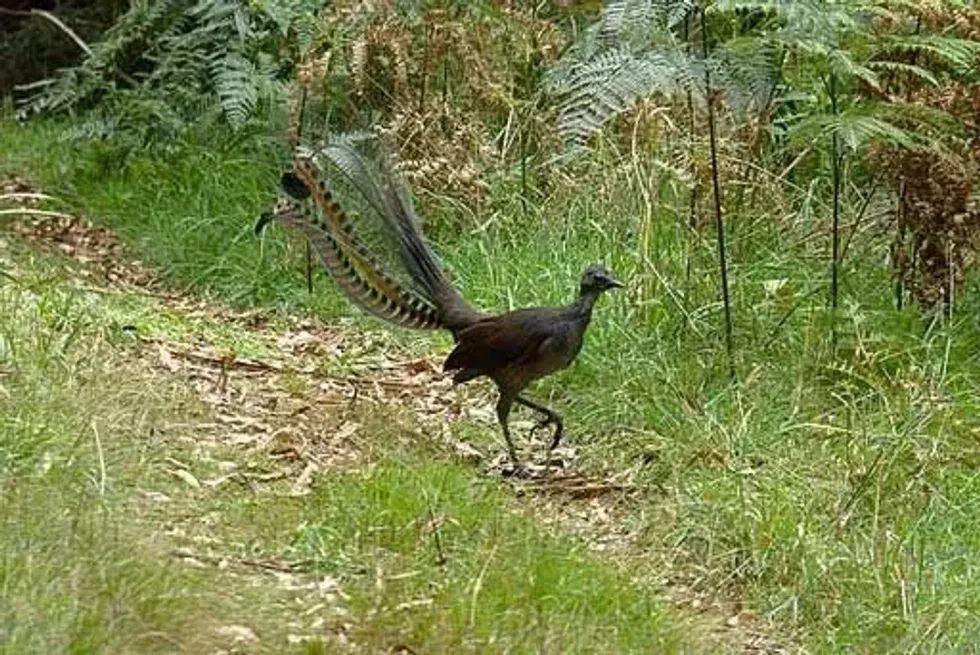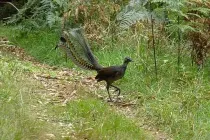The largest among all passerine birds, the lyrebird is one of nature's most showy and performance-loving birds. These are ground-dwelling birds who are indigenous to Australia. They are known for their intricate and showy courtship rituals where they display their ornamental tails.
They are called lyrebirds because their tail feathers resemble the musical instrument, the lyre. These birds can sing very well and mimic the sound made by other birds, animals, or humans.
Their songs can last for about 20 minutes and they have also developed unique calls for their different requirements. The Australian Aboriginal people have also named the bird 'Woorail', 'Weringerong', and 'Bulln-bulln'. This article has some great Australian lyrebird facts including superb lyrebird facts.
If you liked this article with fun facts about the lyrebird, also check out the great articles with facts about the pileated woodpecker and the painted bunting.
Lyrebird Interesting Facts
What type of animal is a Lyrebird?
A lyrebird is a type of bird.
What class of animal does a Lyrebird belong to?
The lyrebird belongs to the Aves class of animals.
How many Lyrebirds are there in the world?
There are around 3500 breeding lyrebirds left in the world as calculated by researchers. The exact population of the superb lyrebird species has not yet been calculated but it can be assumed that they have a stable population.
Where does a Lyrebird live?
The lyrebird is an Australian bird and the species is found on this continent only. The superb lyrebird can be found throughout the rainforests of Australia including those in New South Wales, Victoria, and Queensland. The Albert's lyrebird is a rarer bird and can only be seen in a small portion of the Southern Queensland Rainforest.
What is a Lyrebird's habitat?
Lyrebirds are ground-dwelling and prefer to inhabit wet forests and rainforests and make their homes in moist gullies. In the northern parts of Australia, they are also found in a rugged granite landscape with dead vegetation.
Who do Lyrebirds live with?
Lyrebirds are mostly solitary animals and these birds prefer to live alone when they become adults. However, the young birds stick with their mothers after birth for 6-10 weeks. Male birds become territorial during the breeding season when they start to display their tails and look for mates.
How long does a Lyrebird live?
A superb lyrebird normally lives for approximately 20 years.
How do they reproduce?
Female lyrebirds attain sexual maturity at around five or six years of age and male lyrebirds attain sexual maturity at around six or seven years of age. Lyrebirds mate during the winter season in Australia - between the months of May and August.
During the breeding season, the male superb lyrebird starts to build high mounds of dirt as a part of the courtship ritual.
It uses those mounds as stages upon which it stands and shows off its tail. The Albert's lyrebird is not that showy but only gathers a small pile of twigs to attract females.
Once they have mated, the female lyrebird builds a nest in a moist gully using twigs and sticks. Female lyrebirds lay only one egg which they incubate for 45-50 days.
What is their conservation status?
According to the International Union for Conservation of Nature (IUCN), the superb lyrebird has been listed under the category of 'Least Concern'. IUCN has listed Albert's lyrebird under the category 'Near Threatened' as the population of this species is considered to be in a critical stage and it might be at risk of extinction soon.
Lyrebird Fun Facts
What do Lyrebirds look like?

Superb lyrebirds are more colorful than Albert's lyrebirds. The color of the feather of the superb lyrebird is mostly dark brown, with grey-white underparts. Their feathers are red in color and their wings are short and round.
These birds have a beautiful tail and the tail of an adult male can be up to 28 in (70 cm) long and has sixteen feathers. The outer two feathers of the tail are shaped like the letter 'S' and are named 'lyrate' as they look like a lyre.
There are twelve filamentaries between the lyrates which are flexible and silver-colored. There are also two silver-colored feathers in the middle. The tails of the female birds are less bright and ornate.
The Albert's lyrebirds are chestnut-brown in color with a reddish-brown undertail and throat. Their bill is black and their legs are brownish-grey in color.
Male and female Albert lyrebirds look the same except for their tail. The male bird has a beautiful tail that has long outer lyrates, dark-brown plumes in the middle which look like ribbons, and six pairs of filamentary feathers that are dark grey.
How cute are they?
Lyrebirds are quite cute, especially when the male lyrebirds start to display their tails to attract mates! They may not be very cute to look at or pet like some other birds but their behavior is very cute and adorable.
How do they communicate?
Lyrebirds primarily use sounds to communicate with each other. They have distinct sounds to suit certain situations. They have songs or sounds for when they are marking their territories. They also make a unique sound when they are trying to display themselves to attract females. If they feel threatened, they make loud, high-pitched, alarm-like noises.
How big is a Lyrebird?
Lyrebirds are large pheasant-sized birds. Male superb lyrebirds grow up to 39 in (99 cm) in length while the females grow up to 34 in (86 cm).
Albert's lyrebirds are smaller and the females grow around 30 in (75 cm) in length and males grow up to 35 in (90 cm). The length of their wings is around 30–31 in (76-79 cm) in length.
A red kangaroo is almost twice the size of a grown male lyrebird.
How fast can a Lyrebird fly?
Lyrebirds cannot fly very fast and are not very expert flyers either. Their wings allow them to glide around for short distances or sometimes, jump as high as 2m above the ground. However, they are quite expert runners and can run very fast for a long distance using their strong legs.
How much does a Lyrebird weigh?
A male lyrebird weighs around 2.4 lb (1.1 kg) while a female lyrebird weighs approximately 2.05 lb (0.9 kg).
What are their male and female names of the species?
There are no special or unique names for the male and female types of lyrebirds. Therefore, scientists refer to them as male lyrebirds and female lyrebirds. Male lyrebird facts are very interesting.
What would you call a baby Lyrebird?
A baby lyrebird does not have a separate name so it is usually referred to as a nestling by scientists.
What do they eat?
Lyrebirds hunt down invertebrates like insects, spiders, cockroaches, beetles, centipedes, moths, and frogs for food. They also feed on seeds at times.
Are they dangerous?
Lyrebirds are not dangerous to human beings physically. However, lyrebirds feed on invertebrate smaller animals and prey on them using their strong claw-like feet.
Would they make a good pet?
Lyrebirds would not make good pets. The birds of these species are very shy and do not come near human beings much. They prefer to be left alone in the wild in their natural habitat.
Did you know...
The Albert’s lyrebird was named after Queen Victoria's husband, Prince Albert.
Lyrebirds have a strong olfactory sense which helps them detect poisonous food or chemicals around them.
The Lyrebird's remarkable voice
The Australian lyrebird's voice is one of the most well-known in the world. They have a unique vocal organ or syrinx that allows them to mimic different types of sounds or sing a song that indicates their expression.
The songs of lyrebirds show how well they can do mimicry. They can mimic sounds or songs they hear in their environment including fire alarm sounds, chainsaws, camera shutter sounds, the sounds of babies crying, or even a human voice!
They tend to mimic the calls of other birds or the sound of dogs barking. Their song can sound like chainsaws at times but might seem melodious to others of their type.
Different types of Lyrebird
There are two species of lyrebirds under the genus Menura. The first type of lyrebird is the superb lyrebird (Menura novaehollandiae) which is more ubiquitous in Australia. The other type is rarer and less commonly found in Albert's lyrebird (Menura alberti).
The Albert's lyrebird is less showy than the superb lyrebird and its feathers and tail are of darker, more muted colors as well. However, both these types of Australian lyrebirds can make a wonderful song.
Here at Kidadl, we have carefully created lots of interesting family-friendly animal facts for everyone to discover! Learn more about some other birds including the secretary bird and the blue and yellow macaw.
You can even occupy yourself at home by drawing one of our lyrebird coloring pages.










